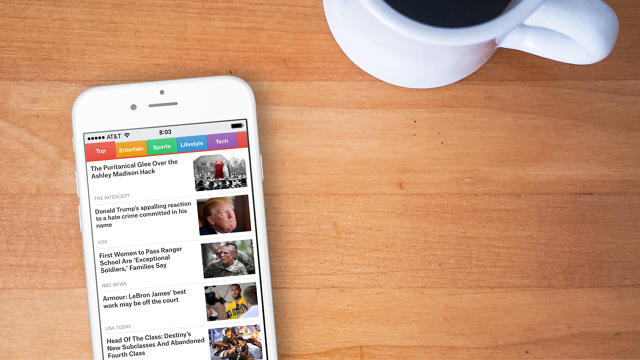Could SmartNews Prove To Be The Media’s Unlikely Sidekick?
In the wake of Facebook’s decision to pull back from publishers and focus more on connecting friends and family, the media is looking for a distribution method it can count on. SmartNews, which just raised $38 million, is hoping to be that app.
“At the end of the day Facebook is about connecting friends; at the end of the day Apple is about selling iPhones. At the end of the day, SmartNews is about news,” says Rich Jaroslovsky, SmartNews resident journalist and content advisor. Jaroslovsky started up the Wall Street Journal’s online edition as managing editor in 1994 and worked at the paper for 27 years.
The app, an aggregator that pulls news from 150 sources in the U.S., chooses news entirely using machine-learning algorithms rather than hiring human curators. For instance, the technology detects when news is being shared widely and quickly. It also looks for duplicate articles, choosing one to represent the news in its feeds. The models are designed to surface the most important and quality news, instead of catering to individual tastes. That strategy is relatively out of sync with most other news apps, which are more inclined to tailor content to individuals.

“I personally am very wary of over-personalization. We think it creates filter bubbles,” says SmartNews communications director Vincent Chang. Jaroslovsky chimes in, “We want to deliver not just the story you already think you want or you saw five times on Facebook, but the stories you might not have seen.” Jaroslovsky works directly with the SmartNews team of engineers to help develop models that facilitate the same kind of serendipitous discovery that flipping through a newspaper used to provide. This is element of surprise and delight is ultimately what SmartNews thinks will prove sticky.
The premise of delivering quality news—rather than the stuff that instigates clicks—smacks of the kind of journalistic integrity that editors can get behind. There’s something for publishers too: SmartNews allows outlets to keep 100% of their ad revenues, while also using the platform. The question is whether it will catch on with consumers in the U.S.
The app has a big hurdle in becoming a destination for news among U.S. citizens. For one, it only has four million downloads in the U.S., a figure that pales in comparison to some of the most popular apps. Last year Flipboard said it had 70 million monthly active users. Earlier this year, Tim Cook announced boasted Apple News had accrued 50 million active readers. But SmartNews has super-high engagement, Chang counters. He says SmartNews users globally spend more than four hours per month on the app. On average Americans tend to devote approximately two hours to news every month, according to the Knight Foundation.
Worldwide the app has 18 million downloads and has forged partnerships with roughly 1,500 publishers for distribution. In particular, it’s big in Japan. There, the company says, it’s developed a profitable ad network that includes video formats. It’s also formed very beneficial relationships with major advertisers, including Netflix, Google, and Paramount Pictures. Local investors have taken note. Much of the $90 million the company has raised since founding has come from Japanese investors.
Chang and Jaroslovsky say the company is hoping to replicate that roadmap in the U.S.
But this is also not the first time the company promised to make a big push into the U.S. market. SmartNews first launched in the U.S. in October 2014. Six months later, after raising a third round of funding, the company said it had its sights fixed pressing forward in the U.S. market. “Having had the experience of successfully monetizing in Japan and having had this luxury of time to refine our approach in the U.S., I think we’ll be ready for it,” says Chang.
This latest round will go toward more research and development into how to handle breaking news, serve up alerts, develop algorithms to highlight quality video in the same way it does written news, and to evolve its ad tech for the U.S. market. It may also go toward a marketing campaign in the states.
While the app may align well with publisher goals, it does face big competition from sleek incumbents like Flipboard and Apple News. SmartNews’ design may be well received in other parts of the world, but it doesn’t measure up to what Americans have come to expect from mobile news apps.
“Technology is number one,” says Chang, noting that Google won the search market because of its powerful technology. A counter argument could be made that its simple design was also a big factor (and a giant contrast to other search engines on the market at the time). But Chang stays firm on his stance, “Time has proven technology to be the winner.”
Of course it’s not just news apps that SmartNews is ultimately competing with. Almost half of all American adults get their news from Facebook, according to Nieman Lab. At the end of the day, publishers will need an ally that doesn’t just share its morals, but one that can gain traction and drive traffic.
Related Video: Facebook Wants To Win At Everything, Including A.I.
Fast Company , Read Full Story
(15)


